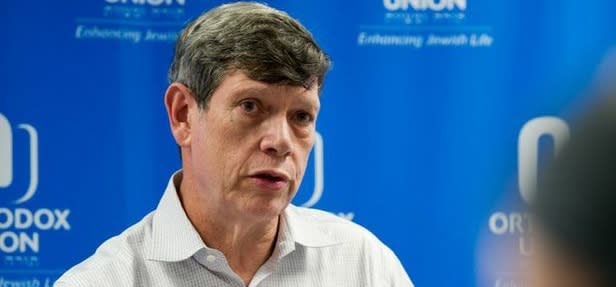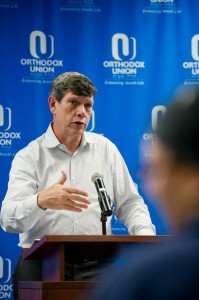Just how common is intermarriage in America?
Professor Steven M. Cohen, a research professor at the Hebrew Union College- Jewish Institute of Religion, held up ten fingers then put down three.
“Seven of these ten Jews will marry non-Jews,” he explained.
Cohen participated in a live webcast at the Orthodox Union on Oct. 8 to explain the results of the latest study of American Jewry, the first-ever conducted by the Pew Research Center. Cohen, a sociologist who was a consultant on the study, said the numbers are grim: the study puts the rate of intermarriage by American Jews at 58%. Excluding the Orthodox, the numbers are even higher, with up to 71% of Jews marrying out of the faith. Those who intermarry are far less likely to raise their children with any Jewish identity. Currently, self-identifying Jews in America account for 2% of the American population, numbering roughly 6.8 million.
However, Cohen explained, the study offers a bright spot for Orthodoxy. The retention rate for those raised Orthodox was surprisingly high, with 83% remaining observant.
Rabbi Steven Weil, senior managing director of the Orthodox Union, credited Jewish day schools for an increase in the Orthodox retention rate over the last such study, released in 2000.
“The primary factor involved in that change is day school education,” he said. “Why is it that we’ve been able to retain such a high percentage? We’ve provided the last generation with a bit more substance. We’ve provided them with a deeper, more meaningful and more engaging Judaism and therefore they, in turn, have a radically different relationship with that Judaism.”
The Orthodox population is also growing. The Orthodox surveyed in the study, which spoke to more than 3,000 Jews across America out of a pool of 70,000 phone calls, were “unusually young and unusually married,” according to Cohen. The average number of children born to Orthodox families is 4.1 compared to an average of 1.7 children in non-Orthodox Jewish families.
A 2012 study on the Jewish population of New York, performed by UJA Federation, gave a strong indication of the change facing American Jewry. Seventy-four percent of Jewish children in New York are Orthodox.
“There are more Hassidic children in New York than Reform and Conservative combined,” Cohen said.
According to the study, Orthodox Jews account for 10% of the Jewish population, Conservative, 18% and Reform 35%. Thirty percent claim no denomination and 6% identify with smaller subgroups. Those numbers might be slightly deceptive, however.
“Orthodox, Conservative and Reform are substitutes for hot, lukewarm and cold,” Cohen explained. “No denomination is freezing. Most reform Jews don’t belong to the temples, half the conservative Jews belong to a synagogue, hardly any no-denomination belong to anything.”
The study also included a population estimate based on the halachic definition of ‘Who is a Jew?’
“In traditional Jewish law (halacha), Jewish identity is passed down through matrilineal descent, and the survey finds that about 90% of Jews by religion and 64% of Jews of no religion – a total of about 4.4 million U.S. adults – say they have a Jewish mother,” the study explained. “Additionally, about 1.3 million people who are not classified as Jews in this report (49% of non-Jews of Jewish background) say they have a Jewish mother.”
Which means, including the estimated 1.3 million Jewish children, the halachic Jewish population of the US is more than six million.
“There’s probably over a million halachic Jews that don’t consider themselves to be Jews,” explained Cohen.
Cohen also offered some of his own views: zip code is a more important predicator of whether someone will marry a Jew than that person’s level of Jewish education. In Cohen’s view, a completely secular Jew with little religious affiliation in New York City is more likely to marry a Jew than the most committed Jew in Phoenix, Arizona.
“People who live in Phoenix or San Francisco or even, by the way, in Suffolk County, who have reasonably high scores on Jewish education and socialization do have higher intermarriage rates when they live outside of areas of heavy Jewish concentration and the opposite is true,” Cohen explained. “A Jewish boy or girl growing up on the Upper West Side with minimal Jewish commitment, that person, because he or she has lived on the Upper West Side, has a much higher rate of marrying a Jew than day school kids in San Francisco.”
Rabbi Weil said that the numbers are grim for the future of American Jewry and a clarion call for Orthodoxy.
“If we don’t spend a large percentage of our lives engaging and opening ourselves up to the majority of American Jews who are unaffiliated, we’re going to relive the experience of losing the Ten Tribes all over again,” he said.
Cohen agreed.
“Orthodox Jews may be tempted to feel triumphant and vindicated,” he said. “But the real challenge to the Orthodox is to engage with non-Orthodox Jews in every way possible. To transcend denominational barriers. To recognize that Orthodox Jews can contribute to increased engagement with Jews and Judaism among the vast majority of American Jews (90%) who are not Orthodox.”
The words of this author reflect his/her own opinions and do not necessarily represent the official position of the Orthodox Union.




